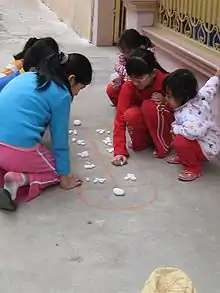Ô ăn quan
Ô ăn quan (literally: Mandarin Square Capturing) is a traditional Vietnamese children's board game. This game is valuable for enhancing calculating and strategical ability.


Board, pieces, and players
- A rectangle which is divided into ten squares (5x2) with two semicircles at each end is drawn on the floor or the yard. The ten squares are called "rice field square", "fish pond square" or "citizen square" and the two semicircles are called "Mandarin squares".
- Pieces may be stones, fruit seeds or any other small things.
- Two players or two teams sit in two sides of the board. Each controls one side of the board.
History
The game's origin is still a mystery to the Vietnamese people, as it has been played for many years. Many people say that Vietnamese ancestors were inspired by green rice fields to invent a game that could be played in those huge fields. At first, the game had become quite popular throughout the country. However, as time passed Vietnamese children no longer had the same passion for the game like those in the past. For this reason, the Vietnam Museum of Ethnology is exhibiting the game with fully explained instructions with the aim of keeping the game alive among children nowadays.
According to many researchers, Ô Ăn Quan belongs to Mancala.
Rules
Setup
Each player places one big stone or ten small stones (called the "Mandarin piece") in the Mandarin square as well as five small stones (called "citizen pieces") in each of the rice field squares.
Object
The game ends when all the pieces are captured.
If both Mandarin pieces are captured, the remaining citizen pieces belong to the player controlling the side that these pieces are on. There is a Vietnamese saying to express this situation: "hết quan, tàn dân, thu quân, bán ruộng" (literally: "Mandarin is gone, citizen dismisses, take back the army, selling the rice field") or "hết quan, tàn dân, thu quân, kéo về" (literally: "Mandarin is gone, citizen dismisses, take back the army, retreat")
Whichever player has more pieces is the winner (a Mandarin piece is equal to ten or five citizen pieces).
Scattering
Players play rock paper scissors to determine the first player.
The first player takes up all the pieces of any rice field square on his/her side of the board and distributes (Vietnamese: rải: literally: scatter) one piece per square, starting at the next square in either direction. When all pieces are distributed, the player repeats by taking up the pieces of the following square and distributing them.
If his/her side of the board is empty, he/she must use five previously-won pieces to place one piece in each square on his/her side before repeating the distribution. (If he/she do not possess any pieces, he/she must borrow a piece from the other player and return it when counting the points at the end of the game.)
Capturing
When the next square to be distributed is empty, the player wins all the pieces in the square after that. A square that contains a lot of pieces is the nhà giàu square (literally: rich square).
When the next square is an empty Mandarin square, or the next two squares are empty, it becomes the other player's turn.
In some game variations, the Mandarin square can contain little citizen pieces called quan non (literally: quan: Madarin, non: young/unripen) which may not be captured.
Song
The children song (Vietnamese: đồng dao) is used when playing this game:
In science
- Mạc Hiển Tích invented số ẩn (negative numbers) from the rules of this game.
In literature
- Saying: "Một đập ăn quan" - literally: "one move captures Mandarin piece": expressing a successful result getting from a simple act.
Variant
A variation of this game exists for three or four players.